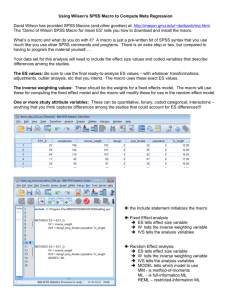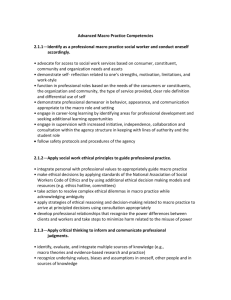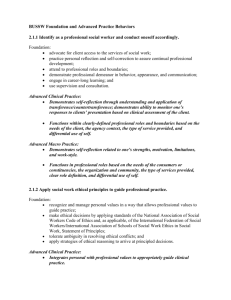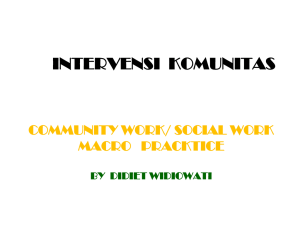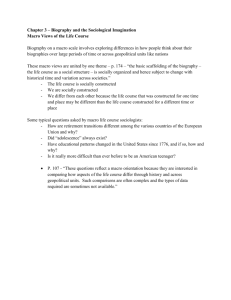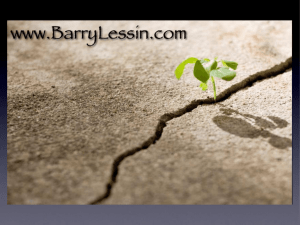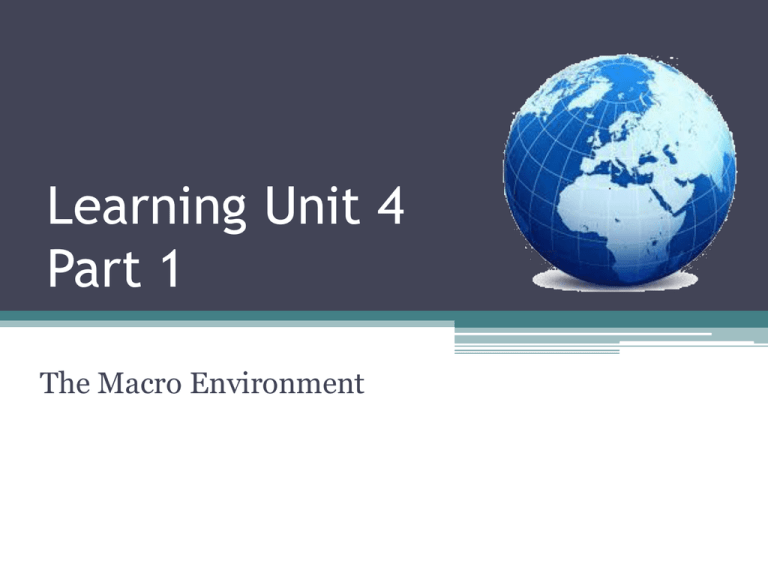
Learning Unit 4
Part 1
The Macro Environment
Learning unit Outcomes
• 4 reasons why managers need to understand the
macro environment.
• Sub-environments of the macro environment.
• Briefly explain the sub-environments.
• What are ‘threats’ and ‘opportunities’ .
• Major economic systems in the world
Learning Outcomes
•
•
•
•
Characteristics of the SA economic system.
The SA government structure.
Corporate governance principles.
Discuss 5 laws that influence management
decisions.
• Discuss BEE and BBBEE in SA.
• Identify and discuss at least 3 sources
provided by SA government to support
business initiative.
External
Market
Macro
Introduction
• Macro environment:
▫
▫
▫
▫
Furthest away
AKA remote environment
Volatile, cannot control
Variables directly and indirectly impact the
business
▫ Variables = uncontrollable = AKA mega trends
▫ Survival = monitor changes indentify
opportunities (maximise) and threats (minimise)
The macro environment
Technological
International
Macro
Social
Economic
Market
Political
Ecological
Micro
The macro environment
Technological
Social
International
Ecological
Opportunity: Variable
has + impact on the
business
Economic
Macro
Political
Change Opportunity or Threat!
Threat: Variable has impact on the business
Characteristics
•
•
•
•
•
Variables are interdependent
Increasingly unstable
Uncertain
Complex
Becoming increasingly unpredictable
Why must managers understand the
macro environment?
•
•
•
•
Direct or indirect impact on all organisations
Adjust to changes in order to survive
Opportunity or threat to be managed
Knowledge and info on macro better decisionmaking
• Knowledge and info on macro pro-active
response to change
Political Environment
• Influence of government on organisations such
as law
• Include:
▫
▫
▫
▫
▫
Sanctions
Wars
Terrorism
Political unrest and instability
Laws
Political Environment
• Government Huge impact on business
• Influence investors decisions
• Examples:
▫
▫
▫
▫
▫
Employment Equity act
National Credit act
Skills Development act
Decrease in subsidies
Department of Environmental Affairs and
Tourism
Employment Equity Act 55 of 1998
• Improve employment equity
• First step: Affirmative action
• On the grounds of:
▫
▫
▫
▫
▫
Race
Sex
Sexual orientation
Disability
Religion
Skills Development Act 97 of 1998
• Develop skills of labour
▫ Improve quality of life
•
•
•
•
Improve productivity and competitiveness
Increase entrepreneurship
SETA: Service Sector Education
and Training Authority
▫ Quality of education/skills training
National Credit Act 34 of 2005
• Protect consumers
• Must be written
• Greater responsibility of credit suppliers
Group Work:
• Identify what possible impact the subenvironments (page 72) of the macro
environment might have on Starbucks in South
Africa
Economic environment
• Health of the country affecting business and
individuals
• General factors in the economic environment:
▫ Employment rates
▫ Distribution of wealth
▫ Competitive pricing in free market
Economic environment
• Factors that affect business:
▫
▫
▫
▫
▫
▫
Economic growth: Increase in production
Employment levels: % people employed
Consumer income: Income Demand for goods
Inflation: Increase in price level of G&S
Exchange rate: One currency for another
Trade balance: Exports - Imports
Economic environment
• Characteristics:
▫ Interdependent
▫ Determine countries prosperity or adversity
▫ Specific implications on business and managers
Social environment
• Concerned with society’s attitudes and cultural
values.
• New trends Continuous appearance New
type of customer.
▫ Healthy eating
• SA workforce large % infected
with HIV/Aids
▫ How does this affect the business?
Social Environment
• Include:
▫
▫
▫
▫
▫
▫
▫
▫
▫
▫
▫
Changing fashion
Changing lifestyle
Role of women in society
Crime and prostitution
Growth in subcultures
Age and race structures
Geographic shifts in population
Family life cycles changing
Education levels increasing
Household sizes decreasing
Birth and death rates
Social Environment
• Other social problems:
▫ Unemployment
▫ Poverty
▫ Crime
• Social changes not always negative!
Social Environment
• Changes in social environment which pose a
threat or opportunity:
▫
▫
▫
▫
More women in the workplace
Move to a more balanced lifestyle
More single-parent households
More single people
Technological Environment
• Include trends such as:
▫
▫
▫
▫
Way customers purchase
Internet
Sophisticated communication channels
Changes in transport
Technological Environment
• The knowledge of how to do something.
• Tech Affect whole organisation.
• Information technology: Combination of people
and technology to support operations,
management and decision-making.
▫ Internet
▫ E-mail
▫ Cellular phones
International Environment
• Operations in SA or internationally direct or
indirect impact.
• Operate internationally Exposed to more
opportunities and threats
▫ Each country has own unique macro environment
Ecological Environment
• Conserve limited resources in the physical
environment.
• Corporate Governance recommend reporting on
‘triple bottom lines’ annually.
Ecological Environment:
- Triple bottom line
To show profit
To benefit from investment
Responsibility of organisations
toward shareholders, people and
environment
Financial
Responsibility
People are better off
Citizenship
Go ‘GREEN’
Take responsibility
for actions
Environmental
Responsibility
Social
Responsibility
Ecological Environment
• Org to report on:
▫
▫
▫
▫
▫
▫
Environmental protection policies
Comply with consumer protection standards
Comply with environmental laws and regulations
Existing and planned pollution control
Protection and restoration costs
Potential liability and current
and pending investigations



